Lepsius list of pyramids
The Lepsius list of pyramids is a list of sixty-seven Ancient Egyptian pyramids established in 1842–1843 by Karl Richard Lepsius (1810–1884), an Egyptologist and leader of the "Prussian expedition to Egypt" from 1842 until 1846.
- For a modern list of Egyptian pyramids see List of Egyptian pyramids

The Lepsius list of pyramid is the first attempt at systematically listing all the Egyptian pyramids, and as such, is a pioneering effort of early modern Egyptology. The list was published together with the results of the expedition in Lepsius work Denkmäler aus Aegypten und Aethiopien (1849–1859).
List
History
.jpg)
Following the success of the Franco-Tuscan Expedition to Egypt under the leadership of Jean-François Champollion, the Prussian scientists Alexander von Humboldt and Robert Wilhelm Bunsen and the minister of instruction Johann Eichhorn recommended to king Frederick William IV that an expedition be sent to Egypt. Karl Richard Lepsius, who had learned of Champollion's method to decipher the hieroglyphs and had met Ippolito Rosellini of the Franco-Tuscan Expedition, was chosen to lead it.[1] The main aim of the expedition was to explore and record the remains of the ancient Egyptian civilization as well as to gather materials for the Egyptian Museum of Berlin.
The Prussian expedition assembled in Alexandria in 1842 and quickly departed for Giza, which was reached in November that same year. Proceeding north to south, Lepsius's men then explored the pyramids field of Abusir, Saqqara, Dahshur and, in 1843, Hawara. Lepsius and team stayed for 6 months in total at these locations, as the Prussian expedition was the first study and record Old Kingdom material in depth.[1]
In total, Lepsius and his men uncovered a total of 67 pyramids and 130 tombs.[1] The pyramids, dating from the Third Dynasty (c. 2686–2613 BCE) until the Thirteenth Dynasty (c. 1800–1650 BCE), were given Roman numerals from north to south, starting from Abu Rawash in the north. Although a few of the structures reported by Lepsius are now known to have been mastabas and other monumental structures (highlighted on the list below in light gray), the Lepsius list of pyramids is still considered a pioneering achievement of modern Egyptology. Lepsius' numerals have remained the standard designation for some of the pyramids.
The results of the Prussian expedition to Egypt, comprising the list of pyramids, were published in the Denkmäler aus Aegypten und Aethiopien.[2]
Pyramids
| Lepsius Number | Location | Modern identification | Image |
|---|---|---|---|
| I | Abu Rawash | Pyramid Lepsius I | |
| II | Abu Rawash | Pyramid of Djedefre | |
| III | Abu Rawash | Pyramid complex of Djedefre, subsidiary pyramid | |
| IV | Giza | Great Pyramid of Giza | |
| V | Giza | North subsidiary pyramid of Khufu's, G-Ia | |
| VI | Giza | Middle subsidiary pyramid of Khufu's, G-Ib | 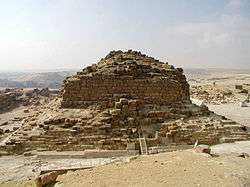 |
| VII | Giza | South subsidiary pyramid of Khufu's, G-Ic | |
| VIII | Giza | Pyramid of Khafre |  |
| IX | Giza | Pyramid of Menkaure |  |
| X | Giza | West subsidiary pyramid of Menkaure's, G-IIIc | |
| XI | Giza | Middle subsidiary pyramid of Menkaure's, G-IIIb | |
| XII | Giza | East subsidiary pyramid of Menkaure's, G-IIIa |  |
| XIII | Zawyet el'Aryan | Unfinished Northern Pyramid of Zawyet el'Aryan |  |
| XIV | Zawyet el'Aryan | Layer Pyramid |  |
| XV | Abu Gorab | Sun temple of Nyuserre Ini |  |
| XVI | Abusir | Unidentified brick pyramid | |
| XVII | Abusir | Sun temple of Userkaf | |
| XVIII | Abusir | Pyramid of Sahure |  |
| XIX | Abusir | Mastaba of vizier Ptahshepses | |
| XX | Abusir | Pyramid of Nyuserre | |
| XXI | Abusir | Pyramid of Neferirkare |  |
| XXII | Abusir | Small satellite pyramid | |
| XXIII | Abusir | Small satellite pyramid | |
| XXIV | Abusir | Pyramid Lepsius XXIV, queen of Nyuserre Ini | |
| XXV | Abusir | Double Pyramid, queen of Nyuserre Ini or Neferefre, could be a double mastaba | |
| XXVI | Abusir | Pyramid of Neferefre | |
| XXVII | Abusir | Completely destroyed, only an outline is visible | |
| XXVIII | Abusir | Unfinished pyramid or a natural structure | |
| XXIX | Saqqara | Headless Pyramid of Menkauhor Kaiu | |
| XXX | Saqqara | Pyramid of Teti |  |
| XXXI | Saqqara | Pyramid of Userkaf | 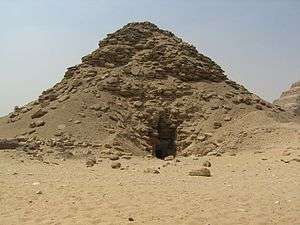 |
| XXXII | Saqqara | Pyramid of Djoser | 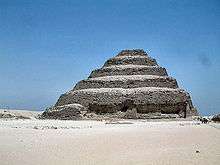 |
| XXXIII | Saqqara | North pavillon of Djoser's pyramid complex | |
| XXXIV | Saqqara | South pavillon of Djoser's pyramid complex |  |
| XXXV | Saqqara | Pyramid of Unas |  |
| XXXVI | Saqqara | Pyramid of Pepi I | |
| XXXVII | Saqqara | Pyramid of Djedkare-Isesi | 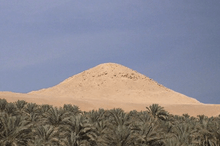 |
| XXXVIII | Saqqara | Subsidiary pyramid to Djedkare's, unknown queen | |
| XXXIX | Saqqara | Pyramid of Merenre | |
| XL | Saqqara | Pyramid of Ibi |  |
| XLI | Saqqara | Pyramid of Pepi II | 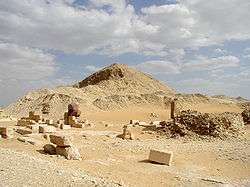 |
| XLII | Saqqara | Subsidiary pyramid of Pepi II's for his queen Wedjebten | |
| XLIII | Saqqara | Mastabat Fara'un of Shepseskaf | 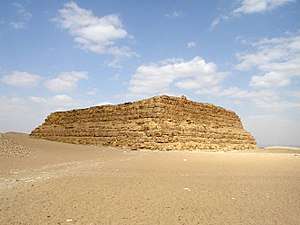 |
| XLIV | Saqqara | Pyramid of Khendjer | |
| XLV | Saqqara | 13th Dynasty structure | |
| XLVI | Saqqara | Southern South Saqqara pyramid |  |
| XLVII | Dahshur | Pyramid of Senusret III |  |
| XLVIII | Dahshur | Mastaba, unknown owner | |
| XLIX | Dahshur | Red Pyramid |  |
| L | Dahshur | Lepsius-L Pyramid | |
| LI | Dahshur | Pyramid of Amenemhat II | |
| LII | Dahshur | Pylon of the temple of the pyramid of Amenemhat II | |
| LIII | Dahshur | Pylon of the temple of the pyramid of Amenemhat II | |
| LIV | Dahshur | Central Dahshur pyramid | |
| LV | Dahshur | Mastaba of vizier Siese | |
| LVI | Dahshur | Bent Pyramid | |
| LVII | Dahshur | Subsidiary pyramid of the bent pyramid | |
| LVIII | Dahshur | Pyramid of Amenemhat III | 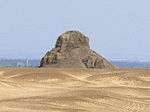 |
| LIX | Dahshur | Northern Mazghuna pyramid | |
| LX | El-Lisht | Pyramid of Amenemhat I | 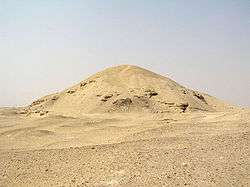 |
| LXI | El-Lisht | Pyramid of Senusret I | 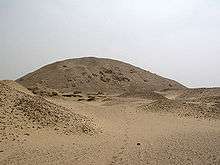 |
| LXII | El-Lisht | Mastaba, unknown owner | |
| LXIII | El-Lisht | Mastaba of Senewosret-Ankh[3] | |
| LXIV | El-Lisht | Mastaba, possibly belonging to a private individual named Senusret[4] | |
| LXV | Meidum | Pyramid of Meidum | |
| LXVI | El-Lahun | Pyramid of Senusret II | 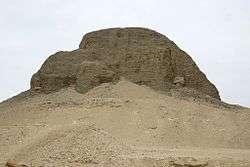 |
| LXVII | Hawara | Pyramid of Hawara, of Amenemhat III. Situated north of "The Labyrinth" |  |
Lepsius' maps
Lepsius drew maps of the locations his expedition visited and which regroup the pyramid listed above. They are presented below, from north to south.
 Abu Rawash
Abu Rawash Giza
Giza Zawyet el'Aryan
Zawyet el'Aryan Saqqara
Saqqara South Saqqara
South Saqqara Dashur
Dashur El-Lisht
El-Lisht Meidum and El-Lahun
Meidum and El-Lahun Hawara
Hawara
References
- Peck 2001, p. 289.
- Lepsius Denkmaler 2016.
- Arnold 2008, pp. 13–24, pls. 2–7, 9–25, pls. 62–92, pl. 129–133..
- Arnold 2008, pp. 24–26, pls. 26–31, pls. 62–92, pl. 129–133.
Bibliography
- Arnold, Dieter (2008). Middle Kingdom Tomb Architecture at Lisht. New York: Metropolitan Museum of Art. ISBN 978-0-300-12344-9.CS1 maint: ref=harv (link)
- "Carl Richard Lepsius "DENKMÄLER AUS AEGYPTEN UND AETHIOPIEN"". Retrieved 8 May 2016.
- Peck, William H. (2001). "Lepsius, Karl Richard". In Redford, Donald B. (ed.). The Oxford Encyclopedia of Ancient Egypt, Volume 2. Oxford University Press. pp. 289–290. ISBN 978-0-19-510234-5.CS1 maint: ref=harv (link)
